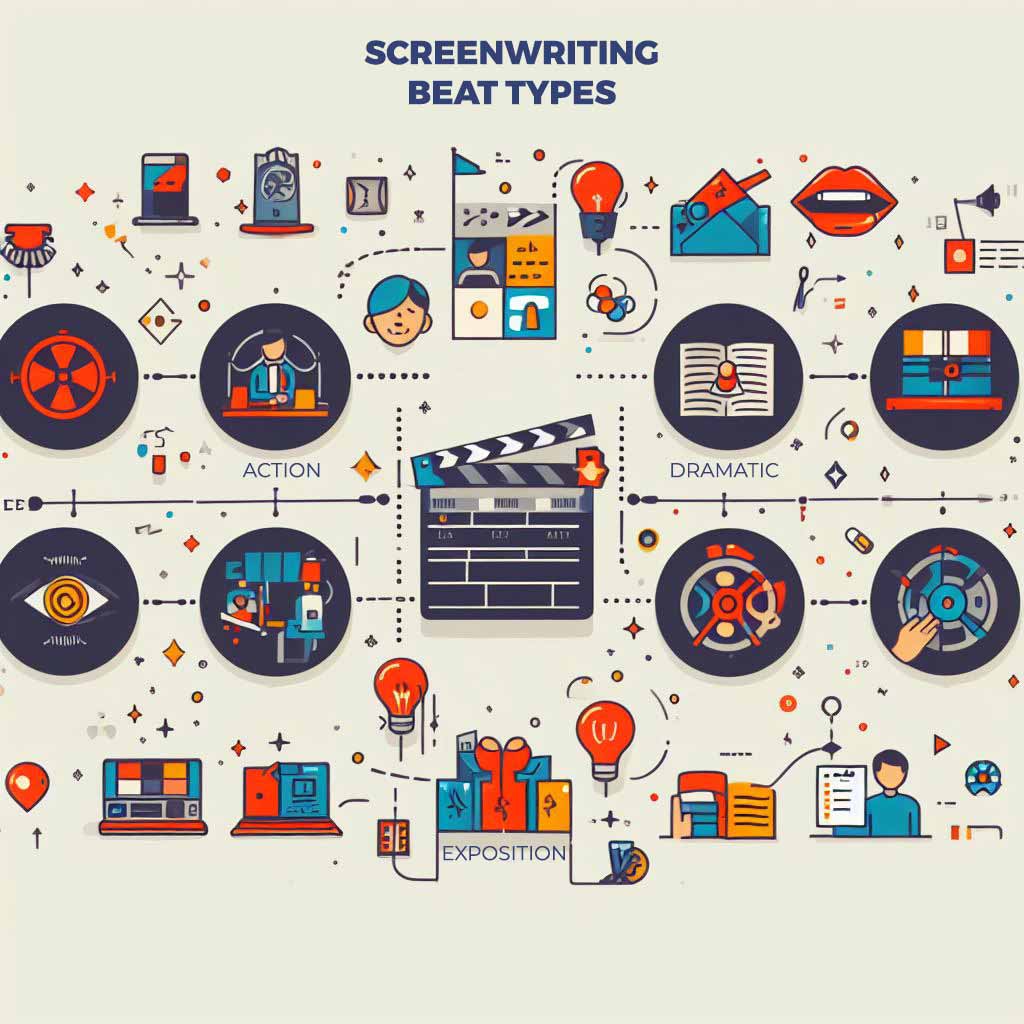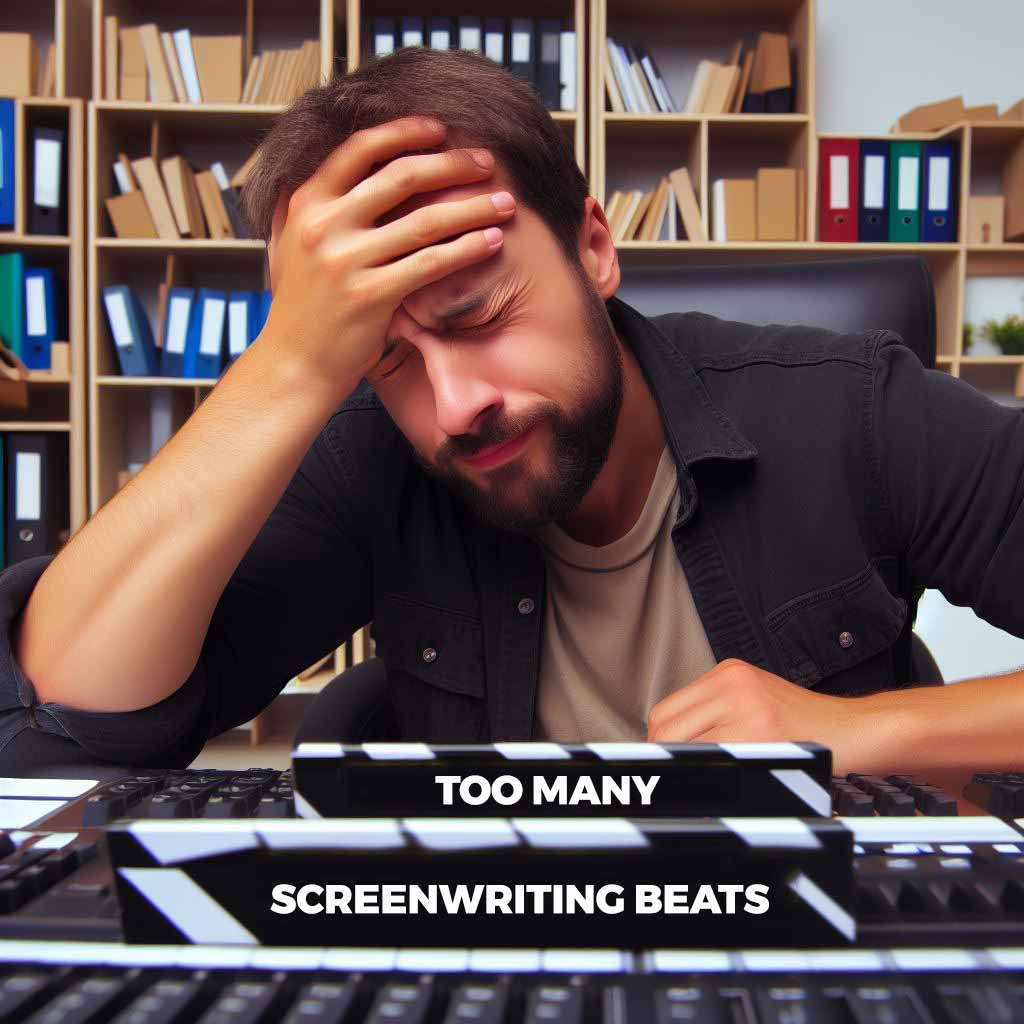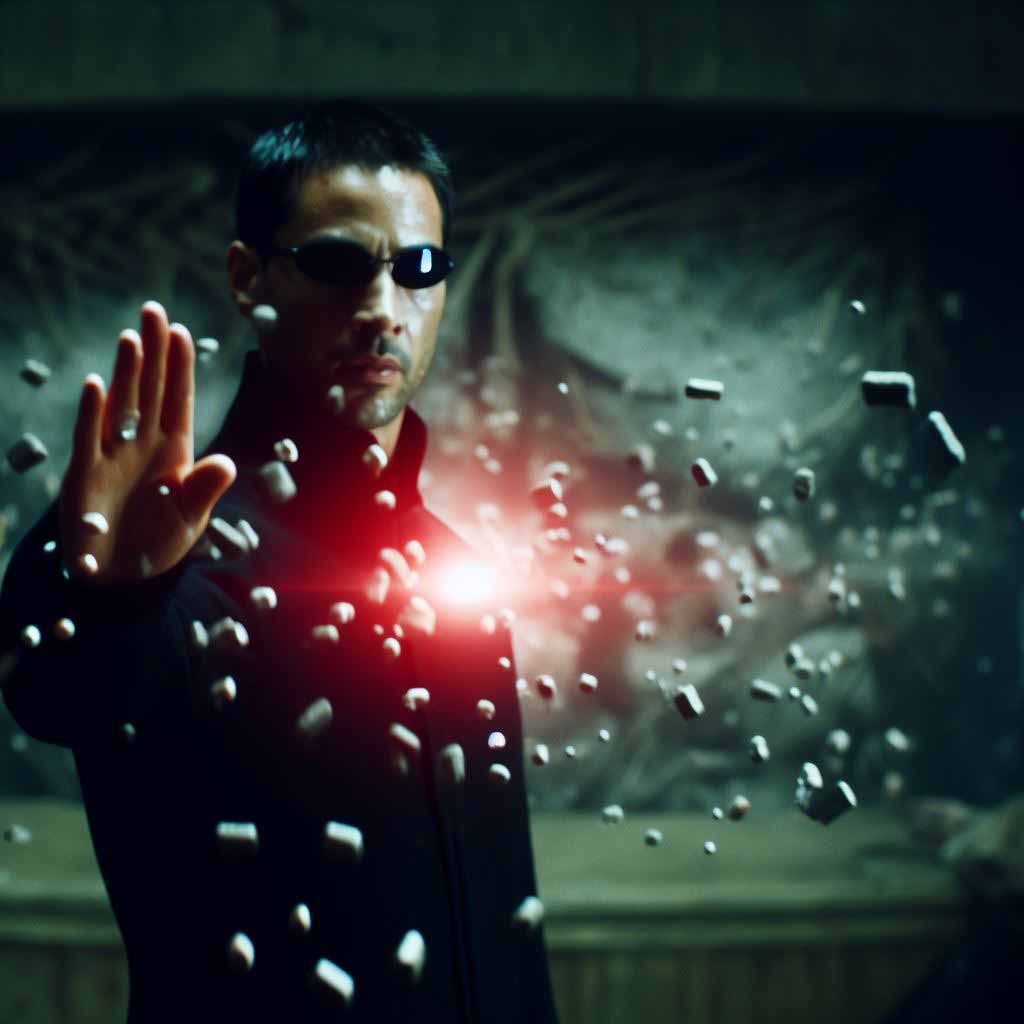When you’re writing a screenplay or any script intended to be made into a film or TV program, you’re not just creating dialogue and stage direction – you’re crafting the very bones that all of the movie magic rests upon. One fundamental element within scene and sequence construction for scripts is “beats.“
But what exactly is a beat in screenwriting? A screenwriting beat is a single story event that occurs to move the overall narrative forward.
Beats are used to break scenes into smaller increments of critical character development or plot points that help shape the overarching story. They provide a sort of rhythm and pacing to propel your script forward.
Effective use of beats across your entire screenplay ensures that your story lingers only as long as it needs to in order to have maximum impact on the audience.
You avoid slow, meandering scenes this way. Most crucially, beats help translate your creative vision as accurately as possible into whatever final form the filmed entertainment will take.
In this comprehensive guide, you will learn:
- The different types of screenwriting beats
- What beats should be accomplished within a script and individual scenes
- Tips on using beats most effectively
- Mistakes to avoid when incorporating beats
- Examples of excellent beats from acclaimed scripts
After absorbing the details and nuances of scriptwriting beats, you’ll be well on your way to incorporating better ones into your next opus – let’s begin!
The Range of Beats That Provide Screenplay Rhythm
Your screenplay is divided up into acts, sequences, scenes, and ultimately beats when zooming into the most minute story details. Beats provide a sort of internal pacing that carries viewers from one critical part of the script to the next.
There are a few broad categories of beats:
Action Beats
As the name suggests, action beats in scripts move the physical story events forward. For example:
EXT. BUS STOP – CONTINUOUS
Kate plops her heavy bag down on the wooden bench and checks her phone. Still, no luck reaching her sister. She looks around nervously just as the bus ROARS into view.
The key story point is Kate arriving at the bus stop after failing to reach her sister – that’s the beat in this scene. The action described will ultimately be translated into actual visuals during filming. Action that progresses the plot or establishes key traits about characters drives stories forward sharply in between critical dialogue.
Dramatic Beats
The emotion of the overall story stems from effective dramatic beats layered judiciously throughout your script. Consider:
INT. AMBER’S APARTMENT – NIGHT
Kate uses her spare key to enter the dark apartment. She slowly walks through the living room when suddenly the overhead light flicks on, revealing Amber sitting nervously on the couch.

This revelation that Amber is home when Kate assumed otherwise is a classic dramatic beat – it packs emotional context and reveals key details in seconds. Dramatic beats go hand-in-hand with impactful dialogue exchanges in scripts.
Backstory & Exposition Beats
Films often must establish context about plot, characters, and timelines – ingredients that enable the actual central story to flow smoothly for viewers.
Cleverly layered beats focused strictly on revealing backstories and parts of characters’ lives that happened off-screen are hugely useful for filling in informational gaps.
For example:
INT. JON’S STUDY – NIGHT – FLASHBACK YOUNG JON (V.O.) Ever since Dad walked out on us two years ago, money’s been tighter than tight around here…
This quick beat establishes some family history central to the main character Jon that impacts current events without needing lengthy tangents. This helps ground the events unfolding in viewers’ minds within logical contexts.
What Screenwriting Beats Should Accomplish
Beats form together to make up single scenes, and string together to drive entire acts and shape the full story arch. Within that hierarchy, effective beats accomplish a few key goals:
- Move The Overall Story Forward First and foremost – beats must advance your plot, narrative, and character arcs in some capacity. The post-beat state should build from the pre-beat state in measurable ways, even if minute at times. Forward momentum keeps the viewer’s eyes glued and turning script pages.
- Reveal Key Details About Characters – Audience emotional investment stems from feeling connected to the players in your cinematic story world. Beats present golden opportunities to showcase quirks, flaws, and motivations – pieces of their essence – so viewers care about outcomes. Even beats focused heavily on the plot can pull double-duty fleshing – out characters.
- Optimize Scene Pacing & Momentum – Sometimes a wide angle lens on story events is perfect. Other times quickly zooming in on succinct beats prevents meandering. Varying beat intensity, length and frequency lets you slightly accelerate, slow, or shift gears to best showcase the most critical elements while sustaining viewer intrigue.
- Know When To Use Beats vs. When Restraint Is Key Not every story nuance warrants its own beat – you avoid overstuffing scenes this way. Sometimes actions, expressions, or dialogue exchanges speak loudly enough. Let heavier dialogue portions involving multiple characters play out, then anchor back to poignant beats. The contrasts optimize the impact of both.
Using Beats More Effectively In Your Scripts
Like any screenwriting technique, improperly utilizing beats can hurt rather than help storytelling and audience immersion. Let’s explore some best practices surrounding beats to boost your skills:
Location Matters
Where precisely you place beats in relation to other story and scene elements influences their effect. Anchoring emotional revelations to end scenes or sequences on a beat versus smack in the middle generates different reactions and tingles spines at just the right moments.
Construct Intentional Beat Sequences
It’s not random which beats you use scene-to-scene in continuity. Master screenwriters sequence complementary beats building toward crescendos. A progression of “ordinary day” beats establishes normalcy before shocking deviations hit harder.
Account For Visual Beats
Scripts lean into heavy visual components once filming starts over novels. Identify beats translating interestingly when shot – intense closeups, marked changes to scenery, contrasting imagery. These will shine on the screen.
Translate Beats Into Actual Film Crafting
Don’t forget screenwriting facilitates an entire collaborative production – your words transform into shot framing, actor expressions, and editing room splicing. Account for directorial interpretations as you architect beat sequences and timing.
Common Beat Mistakes To Avoid
Even seasoned screenwriters fall into traps mishandling beats – these subtle yet serious errors creep in if you don’t remain vigilant:
Don’t Overstuff Scenes
Cramming too many beats into one continuous scene overwhelms viewers struggling to fully absorb information before being shuttled off towards the next story trigger. Apply restraint focusing only on the most hard-hitting developments.
Ensure Logical Beat Placement
Just as critical as beat content is the sequencing and placing of beats so the plot unfolds sensibly to the audience. Flashforwards or ill-timed emotional catharses can undermine immersion. Structure beats so cause and effect make sense.

Only Use Story & Character Relevant Beats
Tangential beats unrelated to protagonists or main events waste valuable script real estate that otherwise could further cement viewer investment. Beats should always intelligently serve defined narrative goals.
Avoid Skipping Necessary Beats
Conversely, missing certain explanatory or transitional beats in an effort to be concise results in disjointed leaps leaving viewers puzzled. Define mandatory baseline beats first the fill with optional flavoring after.
Examples of Impactful Beats In Acclaimed Screenplays
Deconstructing strong examples of beats from critically acclaimed scripts offers helpful models for inspiration:
- The Empire Strikes Back (1980) – Han Solo Frozen In Carbonite – Right as the Empire decisively captures rebel forces, Darth Vader singles out Han Solo for the disturbing carbon-freezing punishment. This dramatic beat leveraging beloved characters rockets immediate tension through audiences that lingers through the entire climax.
- The Matrix (1999) – Neo Realizing His Powers – The iconic scene where Morpheus tests Neo’s combat abilities, ultimately revealing “He’s beginning to believe” introduces a huge beat where both characters and viewers realize his status as The One. This fact reshapes all preceding events and forever alters the playing field going forward.

Key Takeaways & Summary
Whether you’re writing the next summer box office blockbuster, indie film darling, or binge-able streaming series – masterfully incorporating beats into your scripts separates the professionals from amateurs. Remember that beats:
- Provide necessary pacing to scripts via critical story increments
- Move forward with plot, characterization, and emotional engagement
- Must strike balancing restraint and perfect timing
- Can make or break the audience’s experience when finally brought to life
Keep these beat guidelines front of mind during your screenwriting process. Sequence them intentionally to maximum storytelling effect. And never underestimate their importance in anchoring the visions you sling to the silver screen.

Frequently Asked Questions
What does a beat mean in screenplay?
A beat in a screenplay refers to a single story event that moves the narrative forward. Beats break scenes up into smaller story increments that reveal key details about characters and plot.
How many beats are in a screenplay?
There is no set number of beats per screenplay. Experienced writers use as many beats as necessary to progress story events and characters effectively while maintaining good pacing and momentum. Typical screenplays have between 40-60 beats in total.
Is it a beat or a pause in a screenplay?
A beat drives story progression, while a pause allows a brief moment to let an impactful story event sink in. Both are useful tools in screenwriting but serve different purposes.
What does beat mean in dialogue?
In dialogue, a beat refers to a character action inserted into the middle of a speech or line. This gives insight into emotions and reactions using visual cues from the actor.
What is an example of a beat?
An example is “JOHN (angrily): I can’t believe you would do that! (kicks chair) After everything we’ve been through?” The beat is John kicking the chair, revealing his anger.
How to do a beat in a script?
Doing a beat involves breaking up a chunk of dialogue with a relevant character action based on emotions, intentions, and subtext. For example: “I just can’t handle this right now (fights back tears). It’s too much.”
What is the #1 rule when writing a screenplay?
The #1 rule is to make sure each element (action, dialogue, characters, etc.) moves the story forward and contributes to overall narrative goals. Every scene should have purpose and conflict.
What are the 15 beats in a screenplay?
There are no strictly defined 15 beats. But many scripts map story milestones to a 3 or 4-act structure with major turns occurring around pages 12, 25, 55, and 85 of a 100-120-page script.
What does OS mean in a script?
OS stands for “off-screen.” It precedes dialogue to indicate that the speaker can be heard, but is not actually visible in the scene itself initially.


